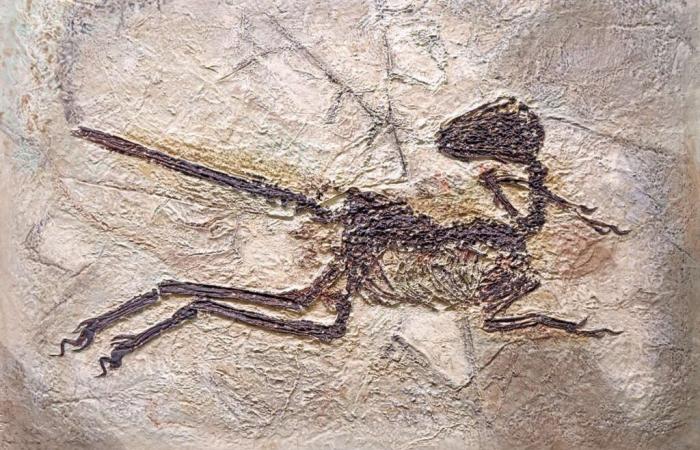
It is called the “Chinese Pompeii”. Located in the north-east of China, this exceptional paleontological site contains a massemasse incredible number of fossils dating from the Lower Cretaceous (between 120 and 130 million years), presenting a truly remarkable state of conservation.
Since the 1990s, there have been numerous fossils of dinosaurs, birds, insects, turtles, frogs and mammalsmammals that were excavated from the Yixian Formation, some with fossilized remains of skin, organs, or feathers. Many of the specimens found on the site have thus become paleontological reference elements of great scientific value. This is also where the first non-avian dinosaurnon-avian dinosaur possessing feathers has been identified. The quality of preservation of the feathers was so high that scientists were able to identify their original colors!
But how can we explain such incredible preservation of fossils?
Fossilization, a not so easy process to carry out
As a reminder, the fossilisationfossilisation is a relatively difficult process to carry out and requires very specific conditions to prevent the entire body from being rapidly decomposed. Compared to the number of dead dinosaurs, only a tiny fraction has seen its remains preserved by a process of mineralization, allowing these bones to survive tens, or even hundreds of millions of years.
It is generally necessary that the body be buried quickly after the death of the animal and that the environmental conditions are anoxicanoxicthat is to say very poor in oxygen. The environment must then remain stable over the very long term to allow the mineralization process to complete. Certain environments are therefore more conducive to producing good quality fossils: when the animal fell into a lagoon for example and was quickly covered by sedimentsedimentwhen the body was carried away during a flood and covered with a thick layer of mud, or when it was quickly buried under ashes during a volcanic eruptionvolcanic eruption.
Frozen scenes of life reminiscent of the Pompeii disaster
The quality of the fossils from the Yixian formation has also led scientists to suspect that violent and sudden volcanic episodes are at their origin. A bit like the catastrophe that ravaged Pompeii in the year 79. The main argument supporting this idea was the presence of numerous perfectly articulated skeletons formed in a continental environment, such as this fossilized scene of a fight between a mammal and a small dinosaur, which seems to have been petrified in the moment. Several catastrophic events of this type would have occurred over a period of approximately 1 million years, giving rise to this fossil sitefossil site extremely rich.
No disaster, but ordinary deaths in a favorable environment
However, a new study published in the journal PNAS came to contradict this hypothesis which had become firmly anchored in recent years. The team led by Scott MacLennan from the University of the Witwatersrand in South Africa has indeed carried out a detailed dating of the different fossils using grains of zirconzircon found in the sediments that included them. The dating of these mineralsminerals revealed that the fossils were systematically dated 125.8 million years ago and that the various animals had died over a period spanning 93,000 years. And over this entire period, nothing catastrophic had actually happened!
The study reveals, however, that the climateclimate was then particularly humid in this region of the world. Conditions that would have drained large quantities of sediment into the bottom of the lakes, quickly burying dead organisms and allowing their preservation. For researchers, there is no evidence that pyroclastic flowspyroclastic flows or torrential volcanic flows have occurred. In this case, these two types of very violent demonstrations would indeed have largely destroyed the bodies, certainly burying them quickly, but not in a connected way and preserving neither the feathers nor the organs.
Small dinosaurs and mammals victims of burrow collapses
On the contrary, many animals appear to have died in their sleepsleepwithout a cataclysm having disrupted their pose. For scientists, there is therefore only one explanation for these observations: thecollapsecollapse burrows in which these small mammals or dinosaurs took refuge. A hypothesis confirmed by the analysis of the grain size of the sediments surrounding the skeletons.
« What was said about preservation [de ces fossiles] to measure lightlight a significant human bias, explains one of the authors in a press release. We tend to attribute extraordinary causes, miracles, to ordinary events when we do not understand their origins. These fossils are just a snapshot of the daily deaths that occurred in normal conditionsnormal conditions over a relatively short period » !





